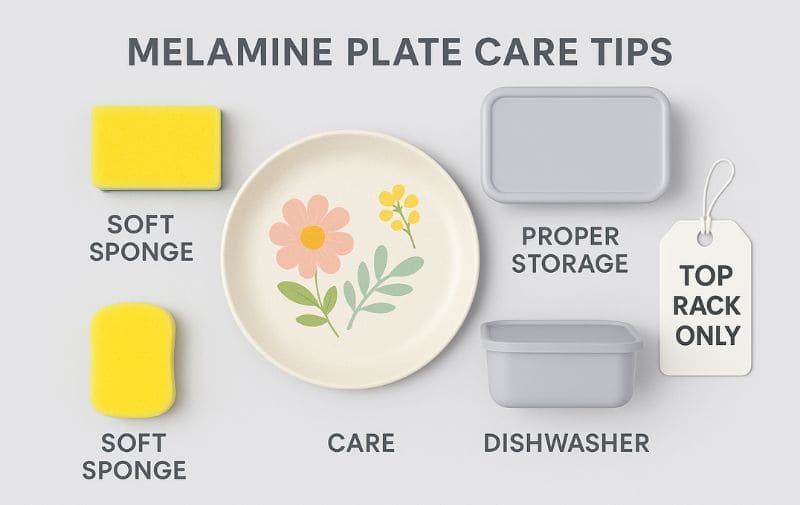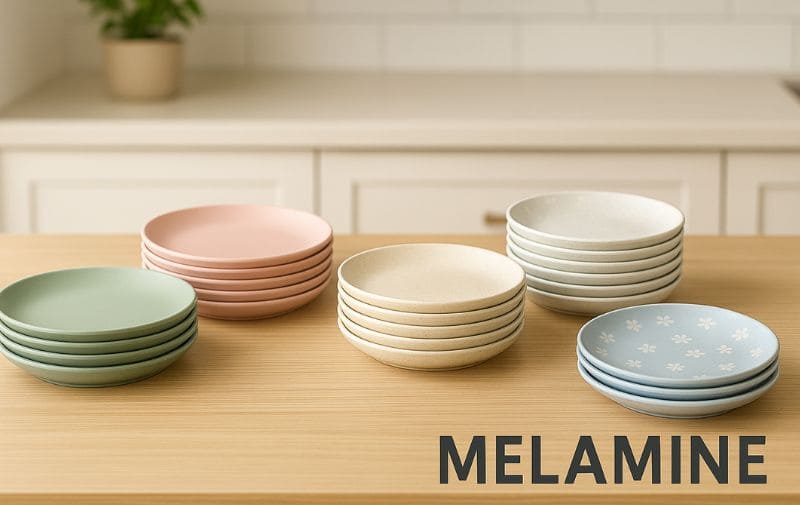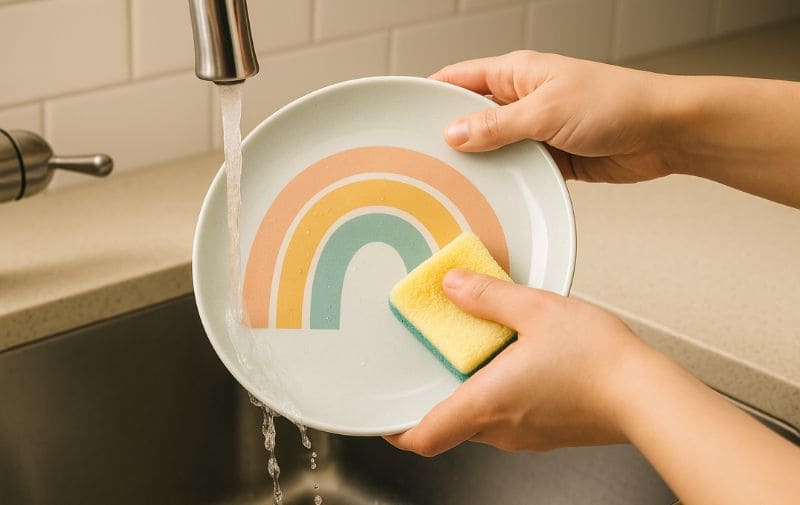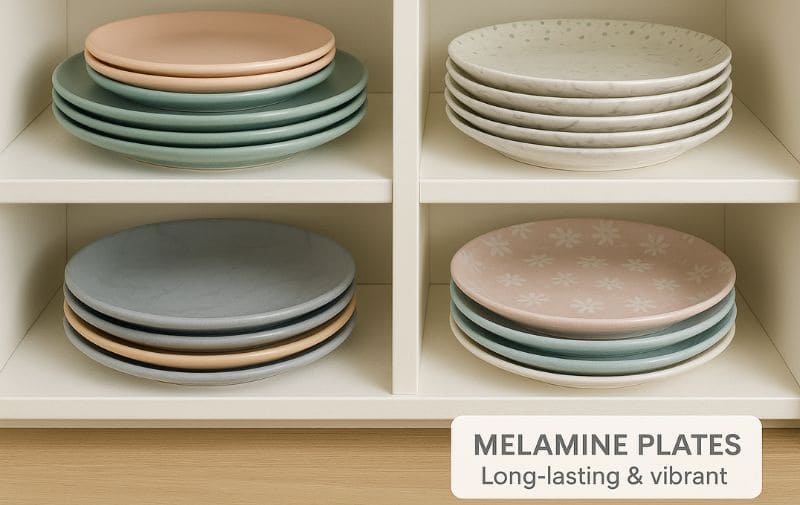- Excessive Scratches: While light surface scratches from cutlery are normal over time, deep or numerous scratches can be problematic. They can make the plate harder to clean thoroughly (potentially harboring bacteria) and diminish its appearance.
- Dull Finish: A significant loss of the original gloss, where the plate looks consistently matte or hazy, can indicate surface wear, often from harsh detergents or very frequent, high-heat dishwashing.
Do stubborn stains that won’t come out mean it’s time for replacement?
If stains from common foods become deeply embedded and can no longer be removed with normal washing or gentle stain treatments (like a baking soda paste), it might suggest the surface has become more porous or damaged.
Should you worry about chips, cracks, or a “chalky” feel?
Yes, these are more serious indicators:
- Chips & Cracks: Any cracks compromise the structural integrity and hygiene of the plate. Significant chips, especially on the eating surface or rim, can also be unhygienic and unsightly. Minor rim chips on an otherwise good plate might be tolerable for some in casual settings, but cracks are a clear sign for replacement.
- “Chalky” Feel: If the surface of the melamine starts to feel powdery or chalky, this is a sign of degradation, potentially from chemical exposure (like very harsh detergents) or severe heat damage (like microwaving). These plates should be discarded. Safety First: If a plate has been repeatedly (and wrongly) microwaved, it’s wise to discard it due to the potential for chemical degradation and compromised structural integrity, even if it looks okay on the surface.
Are Higher-Priced or “Commercial Grade” Melamine Plates Designed to Last Longer?
Generally, yes.
Higher Price Often Reflects Quality
Often (but not always), a higher price tag correlates with the use of 100% A5 melamine, thicker construction, better quality control, and more durable decal application techniques (like in-mold labeling used by brands such as Duramela, which integrates the design into the plate itself).
“Commercial Grade”
This usually implies the product is made from high-quality A5 melamine and designed to withstand the more rigorous demands of food service – frequent washing, stacking, and handling. They are built for enhanced durability and often a longer service life within that demanding commercial context.
Insider Tip:
For commercial clients, the discussion often revolves around “cost per use.” A slightly more expensive A5 plate that lasts 2-3 times longer than a cheaper, lower-grade alternative offers far better long-term value and reduces the operational hassle of frequent reordering and replacement.
How Does the Expected Lifespan of Melamine Compare to Other Plate Materials?
Vs. Ceramic/Porcelain: In terms of breakage, high-quality melamine wins hands down for longevity in environments prone to drops (kids, outdoors, busy kitchens). A dropped ceramic plate is often a goner.
However, well-cared-for ceramic that isn’t dropped can last for generations without showing much surface wear.
Vs. Glass (e.g., Corelle): Corelle is also very break-resistant. Its surface is very hard and less prone to scratching than melamine. Both can have very long lifespans.
Vs. Disposable Plates: No contest. Melamine is designed for years of reuse.
Vs. Other Plastics: Varies wildly. Cheap plastic plates may not last long at all. High-quality A5 melamine generally offers a better aesthetic (more ceramic-like) and often better scratch and heat resistance (for serving) than many other plastic tableware options.
Top Tips: How Can You Make Your Melamine Plates Last as Long as Possible?
- Invest in Quality: Start with 100% A5 melamine from a reputable brand. This is the foundation for a long lifespan.
- NO MICROWAVING – EVER! This is the #1 rule.
- Dishwash Wisely: Top rack, normal heat (avoid sanitize), skip heated dry, use mild detergent.
- Handwash Gently if Preferred: Use a soft cloth or sponge.
- Avoid Abrasives: No steel wool or scouring powders.
- Rinse Promptly: Especially after serving staining foods.
- Don’t Use as Cutting Boards: Minimize direct cutting with serrated knives.
- Store Properly: Avoid wedging them too tightly or stacking excessively heavy items on top. By following these guidelines, you can ensure your melamine dinnerware remains a durable, attractive, and reliable part of your meals for many years to come.

Recommended Internal & External Links:
- Melamine – Wikipedia (Provides general information on melamine resin and its uses)
- Our Collections of Durable A5 Melamine Dinnerware
- Daily Residential Use: Will see more wear than plates used only for weekend BBQs.
- Occasional Use: Can last for many, many years, virtually indefinitely if stored properly.
- Commercial Use: The constant cycling through use, washing, and stacking in high-turnover environments accelerates wear.

Does the type of food served on them (e.g., acidic, staining) make a difference?
To some extent, yes, especially if plates aren’t cleaned promptly.
- Highly Pigmented/Staining Foods: Foods like tomato sauce, turmeric, mustard, berries, or strong coffee/tea can potentially stain melamine if left to sit for extended periods, especially on lower-quality or already scratched surfaces. Prompt rinsing and washing is key. A5 melamine has excellent stain resistance, but it’s not entirely impervious if neglected.
- Acidic Foods: Generally, A5 melamine holds up well to acidic foods (like citrus or vinegar-based dressings) for normal serving durations.
How Does Proper Care (and Misuse) Affect How Long Melamine Plates Last?
This is the biggest user-controlled factor. Proper care can maximize lifespan, while misuse can drastically shorten it.
Can regular dishwasher use shorten the lifespan compared to hand washing?
If done correctly, dishwasher use is fine for A5 melamine. However, incorrect dishwasher habits can accelerate wear:
Top Rack Recommended: Keeps plates away from the direct heat of the bottom heating element.
Avoid “Sanitize” or High-Heat Cycles: Prolonged exposure to temperatures consistently above 70°C (160°F) can degrade melamine over time, making it more brittle.
SKIP “HEATED DRY” CYCLES: This is a major contributor to premature aging, potential warping, and reduced lifespan. The intense, prolonged heat is detrimental. Air drying by opening the dishwasher after the rinse cycle is far better. Many users overlook this simple step.
Mild Detergents: Avoid harsh, abrasive, or overly citrus-based detergents. These can dull the finish and affect decals over many cycles. Handwashing is inherently gentler, but modern A5 melamine is designed to withstand proper dishwashing.
Will using serrated knives or abrasive scrubbers significantly reduce their life?
- Serrated Knives: While generally scratch-resistant to normal cutlery, consistently cutting food directly on melamine plates with sharp, serrated knives can eventually lead to noticeable surface scratches. It’s best to use them as serving plates rather than cutting boards.
- Abrasive Scrubbers: Never use steel wool, harsh scouring pads, or abrasive powder cleaners. These will definitely scratch the surface, dulling the finish and creating micro-grooves where stains and bacteria can more easily accumulate.
Does exposure to very high heat (NOT MICROWAVE) degrade them faster?
Yes. Beyond dishwasher heat, avoid:
- Conventional Ovens/Broilers: Melamine is not designed for these high temperatures and will melt or warp.
- Direct Flames or Hot Stovetops: Obvious no-go. And once more for emphasis: NO MICROWAVING! Microwaving melamine causes it to absorb energy, superheat from within, degrade structurally, become brittle, and potentially leach chemicals. This is the single fastest way to destroy a melamine plate and compromise its safety.

The Impact of Care (or Lack Thereof) on Melamine Lifespan
| Care Practice | Impact on High-Quality A5 Melamine Lifespan | Why It Matters for Your Plates |
|---|---|---|
| Using 100% A5 Melamine | Maximizes Potential Lifespan (Years) | Superior resistance to staining, scratching, heat, and impact. |
| Correct Dishwashing | Maintains good lifespan | Top rack, no sanitize/heated dry, mild detergent prevents stress. |
| NO MICROWAVING (Crucial!) | Drastically Reduces Lifespan & Safety | Causes internal degradation, brittleness, potential leaching. |
| Avoiding Abrasive Scrubbers | Preserves surface gloss and integrity | Prevents scratches that dull appearance and can harbor bacteria. |
| Prompt Cleaning (Staining Foods) | Prevents stubborn stains | Reduces chance of pigments setting into the material. |
| Avoiding Use as Cutting Board | Minimizes deep scratches | Serrated knives can mar the surface over time. |
| Using Lower Grade Melamine | Significantly Shortens Lifespan (Months to Few Years) | More prone to all forms of wear and damage. |
What Are the Common Signs That Your Melamine Plates Are Nearing the End of Their Life?
Even the best plates show wear eventually. Here’s what to look for:
Are excessive scratches or a dull finish key indicators?
- Excessive Scratches: While light surface scratches from cutlery are normal over time, deep or numerous scratches can be problematic. They can make the plate harder to clean thoroughly (potentially harboring bacteria) and diminish its appearance.
- Dull Finish: A significant loss of the original gloss, where the plate looks consistently matte or hazy, can indicate surface wear, often from harsh detergents or very frequent, high-heat dishwashing.
Do stubborn stains that won’t come out mean it’s time for replacement?
If stains from common foods become deeply embedded and can no longer be removed with normal washing or gentle stain treatments (like a baking soda paste), it might suggest the surface has become more porous or damaged.
Should you worry about chips, cracks, or a “chalky” feel?
Yes, these are more serious indicators:
- Chips & Cracks: Any cracks compromise the structural integrity and hygiene of the plate. Significant chips, especially on the eating surface or rim, can also be unhygienic and unsightly. Minor rim chips on an otherwise good plate might be tolerable for some in casual settings, but cracks are a clear sign for replacement.
- “Chalky” Feel: If the surface of the melamine starts to feel powdery or chalky, this is a sign of degradation, potentially from chemical exposure (like very harsh detergents) or severe heat damage (like microwaving). These plates should be discarded. Safety First: If a plate has been repeatedly (and wrongly) microwaved, it’s wise to discard it due to the potential for chemical degradation and compromised structural integrity, even if it looks okay on the surface.
Are Higher-Priced or “Commercial Grade” Melamine Plates Designed to Last Longer?
Generally, yes.
Higher Price Often Reflects Quality
Often (but not always), a higher price tag correlates with the use of 100% A5 melamine, thicker construction, better quality control, and more durable decal application techniques (like in-mold labeling used by brands such as Duramela, which integrates the design into the plate itself).
“Commercial Grade”
This usually implies the product is made from high-quality A5 melamine and designed to withstand the more rigorous demands of food service – frequent washing, stacking, and handling. They are built for enhanced durability and often a longer service life within that demanding commercial context.
Insider Tip:
For commercial clients, the discussion often revolves around “cost per use.” A slightly more expensive A5 plate that lasts 2-3 times longer than a cheaper, lower-grade alternative offers far better long-term value and reduces the operational hassle of frequent reordering and replacement.
How Does the Expected Lifespan of Melamine Compare to Other Plate Materials?
Vs. Ceramic/Porcelain: In terms of breakage, high-quality melamine wins hands down for longevity in environments prone to drops (kids, outdoors, busy kitchens). A dropped ceramic plate is often a goner.
However, well-cared-for ceramic that isn’t dropped can last for generations without showing much surface wear.
Vs. Glass (e.g., Corelle): Corelle is also very break-resistant. Its surface is very hard and less prone to scratching than melamine. Both can have very long lifespans.
Vs. Disposable Plates: No contest. Melamine is designed for years of reuse.
Vs. Other Plastics: Varies wildly. Cheap plastic plates may not last long at all. High-quality A5 melamine generally offers a better aesthetic (more ceramic-like) and often better scratch and heat resistance (for serving) than many other plastic tableware options.
Top Tips: How Can You Make Your Melamine Plates Last as Long as Possible?
- Invest in Quality: Start with 100% A5 melamine from a reputable brand. This is the foundation for a long lifespan.
- NO MICROWAVING – EVER! This is the #1 rule.
- Dishwash Wisely: Top rack, normal heat (avoid sanitize), skip heated dry, use mild detergent.
- Handwash Gently if Preferred: Use a soft cloth or sponge.
- Avoid Abrasives: No steel wool or scouring powders.
- Rinse Promptly: Especially after serving staining foods.
- Don’t Use as Cutting Boards: Minimize direct cutting with serrated knives.
- Store Properly: Avoid wedging them too tightly or stacking excessively heavy items on top. By following these guidelines, you can ensure your melamine dinnerware remains a durable, attractive, and reliable part of your meals for many years to come.

Recommended Internal & External Links:
- Melamine – Wikipedia (Provides general information on melamine resin and its uses)
- Our Collections of Durable A5 Melamine Dinnerware
- Highly Pigmented/Staining Foods: Foods like tomato sauce, turmeric, mustard, berries, or strong coffee/tea can potentially stain melamine if left to sit for extended periods, especially on lower-quality or already scratched surfaces. Prompt rinsing and washing is key. A5 melamine has excellent stain resistance, but it’s not entirely impervious if neglected.
- Acidic Foods: Generally, A5 melamine holds up well to acidic foods (like citrus or vinegar-based dressings) for normal serving durations.
How Does Proper Care (and Misuse) Affect How Long Melamine Plates Last?
This is the biggest user-controlled factor. Proper care can maximize lifespan, while misuse can drastically shorten it.
Can regular dishwasher use shorten the lifespan compared to hand washing?
If done correctly, dishwasher use is fine for A5 melamine. However, incorrect dishwasher habits can accelerate wear:
Top Rack Recommended: Keeps plates away from the direct heat of the bottom heating element.
Avoid “Sanitize” or High-Heat Cycles: Prolonged exposure to temperatures consistently above 70°C (160°F) can degrade melamine over time, making it more brittle.
SKIP “HEATED DRY” CYCLES: This is a major contributor to premature aging, potential warping, and reduced lifespan. The intense, prolonged heat is detrimental. Air drying by opening the dishwasher after the rinse cycle is far better. Many users overlook this simple step.
Mild Detergents: Avoid harsh, abrasive, or overly citrus-based detergents. These can dull the finish and affect decals over many cycles. Handwashing is inherently gentler, but modern A5 melamine is designed to withstand proper dishwashing.
Will using serrated knives or abrasive scrubbers significantly reduce their life?
- Serrated Knives: While generally scratch-resistant to normal cutlery, consistently cutting food directly on melamine plates with sharp, serrated knives can eventually lead to noticeable surface scratches. It’s best to use them as serving plates rather than cutting boards.
- Abrasive Scrubbers: Never use steel wool, harsh scouring pads, or abrasive powder cleaners. These will definitely scratch the surface, dulling the finish and creating micro-grooves where stains and bacteria can more easily accumulate.
Does exposure to very high heat (NOT MICROWAVE) degrade them faster?
Yes. Beyond dishwasher heat, avoid:
- Conventional Ovens/Broilers: Melamine is not designed for these high temperatures and will melt or warp.
- Direct Flames or Hot Stovetops: Obvious no-go. And once more for emphasis: NO MICROWAVING! Microwaving melamine causes it to absorb energy, superheat from within, degrade structurally, become brittle, and potentially leach chemicals. This is the single fastest way to destroy a melamine plate and compromise its safety.

The Impact of Care (or Lack Thereof) on Melamine Lifespan
| Care Practice | Impact on High-Quality A5 Melamine Lifespan | Why It Matters for Your Plates |
|---|---|---|
| Using 100% A5 Melamine | Maximizes Potential Lifespan (Years) | Superior resistance to staining, scratching, heat, and impact. |
| Correct Dishwashing | Maintains good lifespan | Top rack, no sanitize/heated dry, mild detergent prevents stress. |
| NO MICROWAVING (Crucial!) | Drastically Reduces Lifespan & Safety | Causes internal degradation, brittleness, potential leaching. |
| Avoiding Abrasive Scrubbers | Preserves surface gloss and integrity | Prevents scratches that dull appearance and can harbor bacteria. |
| Prompt Cleaning (Staining Foods) | Prevents stubborn stains | Reduces chance of pigments setting into the material. |
| Avoiding Use as Cutting Board | Minimizes deep scratches | Serrated knives can mar the surface over time. |
| Using Lower Grade Melamine | Significantly Shortens Lifespan (Months to Few Years) | More prone to all forms of wear and damage. |
What Are the Common Signs That Your Melamine Plates Are Nearing the End of Their Life?
Even the best plates show wear eventually. Here’s what to look for:
Are excessive scratches or a dull finish key indicators?
- Excessive Scratches: While light surface scratches from cutlery are normal over time, deep or numerous scratches can be problematic. They can make the plate harder to clean thoroughly (potentially harboring bacteria) and diminish its appearance.
- Dull Finish: A significant loss of the original gloss, where the plate looks consistently matte or hazy, can indicate surface wear, often from harsh detergents or very frequent, high-heat dishwashing.
Do stubborn stains that won’t come out mean it’s time for replacement?
If stains from common foods become deeply embedded and can no longer be removed with normal washing or gentle stain treatments (like a baking soda paste), it might suggest the surface has become more porous or damaged.
Should you worry about chips, cracks, or a “chalky” feel?
Yes, these are more serious indicators:
- Chips & Cracks: Any cracks compromise the structural integrity and hygiene of the plate. Significant chips, especially on the eating surface or rim, can also be unhygienic and unsightly. Minor rim chips on an otherwise good plate might be tolerable for some in casual settings, but cracks are a clear sign for replacement.
- “Chalky” Feel: If the surface of the melamine starts to feel powdery or chalky, this is a sign of degradation, potentially from chemical exposure (like very harsh detergents) or severe heat damage (like microwaving). These plates should be discarded. Safety First: If a plate has been repeatedly (and wrongly) microwaved, it’s wise to discard it due to the potential for chemical degradation and compromised structural integrity, even if it looks okay on the surface.
Are Higher-Priced or “Commercial Grade” Melamine Plates Designed to Last Longer?
Generally, yes.
Higher Price Often Reflects Quality
Often (but not always), a higher price tag correlates with the use of 100% A5 melamine, thicker construction, better quality control, and more durable decal application techniques (like in-mold labeling used by brands such as Duramela, which integrates the design into the plate itself).
“Commercial Grade”
This usually implies the product is made from high-quality A5 melamine and designed to withstand the more rigorous demands of food service – frequent washing, stacking, and handling. They are built for enhanced durability and often a longer service life within that demanding commercial context.
Insider Tip:
For commercial clients, the discussion often revolves around “cost per use.” A slightly more expensive A5 plate that lasts 2-3 times longer than a cheaper, lower-grade alternative offers far better long-term value and reduces the operational hassle of frequent reordering and replacement.
How Does the Expected Lifespan of Melamine Compare to Other Plate Materials?
Vs. Ceramic/Porcelain: In terms of breakage, high-quality melamine wins hands down for longevity in environments prone to drops (kids, outdoors, busy kitchens). A dropped ceramic plate is often a goner.
However, well-cared-for ceramic that isn’t dropped can last for generations without showing much surface wear.
Vs. Glass (e.g., Corelle): Corelle is also very break-resistant. Its surface is very hard and less prone to scratching than melamine. Both can have very long lifespans.
Vs. Disposable Plates: No contest. Melamine is designed for years of reuse.
Vs. Other Plastics: Varies wildly. Cheap plastic plates may not last long at all. High-quality A5 melamine generally offers a better aesthetic (more ceramic-like) and often better scratch and heat resistance (for serving) than many other plastic tableware options.
Top Tips: How Can You Make Your Melamine Plates Last as Long as Possible?
- Invest in Quality: Start with 100% A5 melamine from a reputable brand. This is the foundation for a long lifespan.
- NO MICROWAVING – EVER! This is the #1 rule.
- Dishwash Wisely: Top rack, normal heat (avoid sanitize), skip heated dry, use mild detergent.
- Handwash Gently if Preferred: Use a soft cloth or sponge.
- Avoid Abrasives: No steel wool or scouring powders.
- Rinse Promptly: Especially after serving staining foods.
- Don’t Use as Cutting Boards: Minimize direct cutting with serrated knives.
- Store Properly: Avoid wedging them too tightly or stacking excessively heavy items on top. By following these guidelines, you can ensure your melamine dinnerware remains a durable, attractive, and reliable part of your meals for many years to come.

Recommended Internal & External Links:
- Melamine – Wikipedia (Provides general information on melamine resin and its uses)
- Our Collections of Durable A5 Melamine Dinnerware
- Daily Residential Use: Will see more wear than plates used only for weekend BBQs.
- Occasional Use: Can last for many, many years, virtually indefinitely if stored properly.
- Commercial Use: The constant cycling through use, washing, and stacking in high-turnover environments accelerates wear.

Does the type of food served on them (e.g., acidic, staining) make a difference?
To some extent, yes, especially if plates aren’t cleaned promptly.
- Highly Pigmented/Staining Foods: Foods like tomato sauce, turmeric, mustard, berries, or strong coffee/tea can potentially stain melamine if left to sit for extended periods, especially on lower-quality or already scratched surfaces. Prompt rinsing and washing is key. A5 melamine has excellent stain resistance, but it’s not entirely impervious if neglected.
- Acidic Foods: Generally, A5 melamine holds up well to acidic foods (like citrus or vinegar-based dressings) for normal serving durations.
How Does Proper Care (and Misuse) Affect How Long Melamine Plates Last?
This is the biggest user-controlled factor. Proper care can maximize lifespan, while misuse can drastically shorten it.
Can regular dishwasher use shorten the lifespan compared to hand washing?
If done correctly, dishwasher use is fine for A5 melamine. However, incorrect dishwasher habits can accelerate wear:
Top Rack Recommended: Keeps plates away from the direct heat of the bottom heating element.
Avoid “Sanitize” or High-Heat Cycles: Prolonged exposure to temperatures consistently above 70°C (160°F) can degrade melamine over time, making it more brittle.
SKIP “HEATED DRY” CYCLES: This is a major contributor to premature aging, potential warping, and reduced lifespan. The intense, prolonged heat is detrimental. Air drying by opening the dishwasher after the rinse cycle is far better. Many users overlook this simple step.
Mild Detergents: Avoid harsh, abrasive, or overly citrus-based detergents. These can dull the finish and affect decals over many cycles. Handwashing is inherently gentler, but modern A5 melamine is designed to withstand proper dishwashing.
Will using serrated knives or abrasive scrubbers significantly reduce their life?
- Serrated Knives: While generally scratch-resistant to normal cutlery, consistently cutting food directly on melamine plates with sharp, serrated knives can eventually lead to noticeable surface scratches. It’s best to use them as serving plates rather than cutting boards.
- Abrasive Scrubbers: Never use steel wool, harsh scouring pads, or abrasive powder cleaners. These will definitely scratch the surface, dulling the finish and creating micro-grooves where stains and bacteria can more easily accumulate.
Does exposure to very high heat (NOT MICROWAVE) degrade them faster?
Yes. Beyond dishwasher heat, avoid:
- Conventional Ovens/Broilers: Melamine is not designed for these high temperatures and will melt or warp.
- Direct Flames or Hot Stovetops: Obvious no-go. And once more for emphasis: NO MICROWAVING! Microwaving melamine causes it to absorb energy, superheat from within, degrade structurally, become brittle, and potentially leach chemicals. This is the single fastest way to destroy a melamine plate and compromise its safety.

The Impact of Care (or Lack Thereof) on Melamine Lifespan
| Care Practice | Impact on High-Quality A5 Melamine Lifespan | Why It Matters for Your Plates |
|---|---|---|
| Using 100% A5 Melamine | Maximizes Potential Lifespan (Years) | Superior resistance to staining, scratching, heat, and impact. |
| Correct Dishwashing | Maintains good lifespan | Top rack, no sanitize/heated dry, mild detergent prevents stress. |
| NO MICROWAVING (Crucial!) | Drastically Reduces Lifespan & Safety | Causes internal degradation, brittleness, potential leaching. |
| Avoiding Abrasive Scrubbers | Preserves surface gloss and integrity | Prevents scratches that dull appearance and can harbor bacteria. |
| Prompt Cleaning (Staining Foods) | Prevents stubborn stains | Reduces chance of pigments setting into the material. |
| Avoiding Use as Cutting Board | Minimizes deep scratches | Serrated knives can mar the surface over time. |
| Using Lower Grade Melamine | Significantly Shortens Lifespan (Months to Few Years) | More prone to all forms of wear and damage. |
What Are the Common Signs That Your Melamine Plates Are Nearing the End of Their Life?
Even the best plates show wear eventually. Here’s what to look for:
Are excessive scratches or a dull finish key indicators?
- Excessive Scratches: While light surface scratches from cutlery are normal over time, deep or numerous scratches can be problematic. They can make the plate harder to clean thoroughly (potentially harboring bacteria) and diminish its appearance.
- Dull Finish: A significant loss of the original gloss, where the plate looks consistently matte or hazy, can indicate surface wear, often from harsh detergents or very frequent, high-heat dishwashing.
Do stubborn stains that won’t come out mean it’s time for replacement?
If stains from common foods become deeply embedded and can no longer be removed with normal washing or gentle stain treatments (like a baking soda paste), it might suggest the surface has become more porous or damaged.
Should you worry about chips, cracks, or a “chalky” feel?
Yes, these are more serious indicators:
- Chips & Cracks: Any cracks compromise the structural integrity and hygiene of the plate. Significant chips, especially on the eating surface or rim, can also be unhygienic and unsightly. Minor rim chips on an otherwise good plate might be tolerable for some in casual settings, but cracks are a clear sign for replacement.
- “Chalky” Feel: If the surface of the melamine starts to feel powdery or chalky, this is a sign of degradation, potentially from chemical exposure (like very harsh detergents) or severe heat damage (like microwaving). These plates should be discarded. Safety First: If a plate has been repeatedly (and wrongly) microwaved, it’s wise to discard it due to the potential for chemical degradation and compromised structural integrity, even if it looks okay on the surface.
Are Higher-Priced or “Commercial Grade” Melamine Plates Designed to Last Longer?
Generally, yes.
Higher Price Often Reflects Quality
Often (but not always), a higher price tag correlates with the use of 100% A5 melamine, thicker construction, better quality control, and more durable decal application techniques (like in-mold labeling used by brands such as Duramela, which integrates the design into the plate itself).
“Commercial Grade”
This usually implies the product is made from high-quality A5 melamine and designed to withstand the more rigorous demands of food service – frequent washing, stacking, and handling. They are built for enhanced durability and often a longer service life within that demanding commercial context.
Insider Tip:
For commercial clients, the discussion often revolves around “cost per use.” A slightly more expensive A5 plate that lasts 2-3 times longer than a cheaper, lower-grade alternative offers far better long-term value and reduces the operational hassle of frequent reordering and replacement.
How Does the Expected Lifespan of Melamine Compare to Other Plate Materials?
Vs. Ceramic/Porcelain: In terms of breakage, high-quality melamine wins hands down for longevity in environments prone to drops (kids, outdoors, busy kitchens). A dropped ceramic plate is often a goner.
However, well-cared-for ceramic that isn’t dropped can last for generations without showing much surface wear.
Vs. Glass (e.g., Corelle): Corelle is also very break-resistant. Its surface is very hard and less prone to scratching than melamine. Both can have very long lifespans.
Vs. Disposable Plates: No contest. Melamine is designed for years of reuse.
Vs. Other Plastics: Varies wildly. Cheap plastic plates may not last long at all. High-quality A5 melamine generally offers a better aesthetic (more ceramic-like) and often better scratch and heat resistance (for serving) than many other plastic tableware options.
Top Tips: How Can You Make Your Melamine Plates Last as Long as Possible?
- Invest in Quality: Start with 100% A5 melamine from a reputable brand. This is the foundation for a long lifespan.
- NO MICROWAVING – EVER! This is the #1 rule.
- Dishwash Wisely: Top rack, normal heat (avoid sanitize), skip heated dry, use mild detergent.
- Handwash Gently if Preferred: Use a soft cloth or sponge.
- Avoid Abrasives: No steel wool or scouring powders.
- Rinse Promptly: Especially after serving staining foods.
- Don’t Use as Cutting Boards: Minimize direct cutting with serrated knives.
- Store Properly: Avoid wedging them too tightly or stacking excessively heavy items on top. By following these guidelines, you can ensure your melamine dinnerware remains a durable, attractive, and reliable part of your meals for many years to come.

Recommended Internal & External Links:
- Melamine – Wikipedia (Provides general information on melamine resin and its uses)
- Our Collections of Durable A5 Melamine Dinnerware




